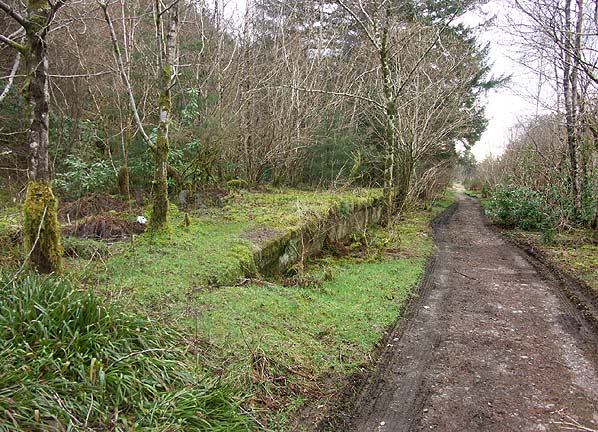|
Notes: Invergarry Station had a substantial island platform accessed by a subway or underpass at the south end with a covered ramp up to the platform. One siding served a goods shed and loading bank on the west side of the station with a second siding on its west side.
The station was remotely sited, Invergarry village and house are on the opposite side of Loch Oich.The station was provided with a private waiting room for use by visitors to Invergarry House home of the laird of Glengarry. The house was built north of the ruined Glengarry Castle but is now known as the Glengarry Castle Hotel.
After closure to passengers in 1933 the station remained open for goods traffic closing with the line on 1 January 1947, a year before nationalisation.
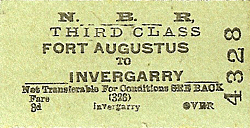 In February 2012 a preservation society was formed. The society's aim was to clear the trackbed of vegetation and create a static museum. Their volunteers have now cleared the platform but two large tree stumps have yet to be removed. They will soon be ready to excavate the foundations of the buildings. Archaeological digs have already confirmed the site of the toilets, including a cistern from the ladies and the position of the water columns and one pump house. In February 2012 a preservation society was formed. The society's aim was to clear the trackbed of vegetation and create a static museum. Their volunteers have now cleared the platform but two large tree stumps have yet to be removed. They will soon be ready to excavate the foundations of the buildings. Archaeological digs have already confirmed the site of the toilets, including a cistern from the ladies and the position of the water columns and one pump house.
The trackbed adjacent to platform 1 has now been completely cleared as is 90% of platform 2. The underpass has been painted and the surrounding area cleared ready for the installation of a notice board.
Work will shortly start on the manufacture of station signs and other items for the platform and sections of track and freight vehicles have been sought for display on a short goods train. After 66 years first track panels were laid in platform 1 on 25 March 2014
The Invergarry Station Project enjoys the support of the local MSP, Dave Thompson, The Great Glen Way, Sustrans, Forestry Commission, Historic Scotland, The Heritage Railway Association, Glengarry Heritage Centre and the local community, many of whom are working members of the Society. Being sited on both the Great Glen Way and proposed Sustrans National Cycle Route between Fort William and Inverness, as well as being within walking distance of the A82, it is hoped the museum will attract interest from the general public as well as rail enthusiasts.
Latest news 1 July 2014: The group been promised 450ft track and at least one set of points. They expect delivery towards end of July 2014 along with ballast. An Inverness firm have agreed to construct a replica signal cabin at cost. The Forestry Commission have agreed to clear back from the cess to the boundary fence adjacent to platform 2 by the end of July which will enabled the track bed to be prepared. A replica Invergarry Station sign is also currently under construction.
The Invergarry Station Preservation Society have two web sites: The Station Project and Invergarry & Fort Augustus Railway Museum
BRIEF HISTORY OF THE INVERGARRY & FORT AUGUSTUS RAILWAY
A group of local businessmen and landowners formed the Invergarry and Fort Augustus Railway Company proposing a line from Spean Bridge on the West Highland line to Fort Augustus at the south end of Loch Ness. It was hoped that the line could be extended at both ends and would eventually connect Glasgow with Inverness. Although they had little money to run the line themselves, it was decided to build the line and then sell it to the highest bidder.
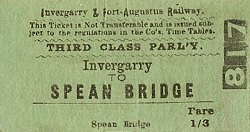 The line was unsuccessfully opposed, by the Highland Railway and the Act was passed on 14th August 1896. Construction started the following year and after a final inspection by the Board of Trade on 14th July 1903, the branch opened eight days later on 22nd July. The line was largely funded by Lord Burton and was an expensive venture, built to main-line standards, so convinced were its promoters that it would ultimately become part of a ‘Great Glen’ trunk route. The line was unsuccessfully opposed, by the Highland Railway and the Act was passed on 14th August 1896. Construction started the following year and after a final inspection by the Board of Trade on 14th July 1903, the branch opened eight days later on 22nd July. The line was largely funded by Lord Burton and was an expensive venture, built to main-line standards, so convinced were its promoters that it would ultimately become part of a ‘Great Glen’ trunk route.
 There was a station in the centre of Fort Augustus, but the line extended to a pier on Loch Ness to allow connection with steamers. Other intermediate stations were provided at Aberchalder, Invergarry and Gairlochy. A further station at Invergloy was opened on 1st July 1904. The line was single track throughout with passing places at Gairlochy & Invergarry Stations and at Letterfinlay Crossing which was planned to break the long single track section from Gairlochy to Invergarry. This crossing was never brought into use although signaling equipment was installed and a signal box built. There was a station in the centre of Fort Augustus, but the line extended to a pier on Loch Ness to allow connection with steamers. Other intermediate stations were provided at Aberchalder, Invergarry and Gairlochy. A further station at Invergloy was opened on 1st July 1904. The line was single track throughout with passing places at Gairlochy & Invergarry Stations and at Letterfinlay Crossing which was planned to break the long single track section from Gairlochy to Invergarry. This crossing was never brought into use although signaling equipment was installed and a signal box built.
Meanwhile, in 1897, a light railway had been proposed from Inverness via Dunain to Lochend, where a pier would allow connection with the loch steamers. Although this line was not actually a Highland Railway proposal (they having agreed not to promote any railways in the Great Glen), the Invergarry and Fort Augustus Railway were suspicious of Highland Railway
involvement and opposed the Lochend line, believing it would prevent the company ever extending to Inverness. The opposition was successful, and the Lochend line did not proceed.
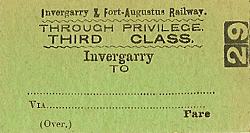 The line cost £350,000 to build and this cost exhausted the capital of the Invergarry and Fort Augustus Railway Co. with no money left to provide rolling stock and operate the line; so the service was initially provided by the Highland Railway who rented the line at £4,000 per year even though it was detached from its own system. The railway turned out to be a financial disaster. The villages it served were sparsely inhabited and the only forms of revenue were on Market Day and the use of the line by monks attending a Seminary nearby. The line cost £350,000 to build and this cost exhausted the capital of the Invergarry and Fort Augustus Railway Co. with no money left to provide rolling stock and operate the line; so the service was initially provided by the Highland Railway who rented the line at £4,000 per year even though it was detached from its own system. The railway turned out to be a financial disaster. The villages it served were sparsely inhabited and the only forms of revenue were on Market Day and the use of the line by monks attending a Seminary nearby.

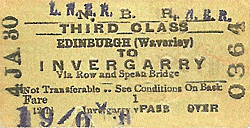 The section from Fort Augustus Town station to the pier on Loch Ness, incorporating a swing bridge on the canal, a major bridge over the River Lochy a bridge over the main road, a terminal station and pier was closed in 1906 after only three years’ use. The line was worked by the North British Railway from 1st May 1907 but between 1st November 1911 and 1st August 1913 there was no service at all, as the North British was not prepared to lose any more money and were only willing to restore a service when the line was sold outright to them. They paid £27,000 for the line and the Fort Augustus Hotel, a fraction of the £350,000 cost of building the branch. They were then able to operate the line under the North British Railway (Invergarry and Fort Augustus) Vesting and Confirmation Act of 28th August 1914. The section from Fort Augustus Town station to the pier on Loch Ness, incorporating a swing bridge on the canal, a major bridge over the River Lochy a bridge over the main road, a terminal station and pier was closed in 1906 after only three years’ use. The line was worked by the North British Railway from 1st May 1907 but between 1st November 1911 and 1st August 1913 there was no service at all, as the North British was not prepared to lose any more money and were only willing to restore a service when the line was sold outright to them. They paid £27,000 for the line and the Fort Augustus Hotel, a fraction of the £350,000 cost of building the branch. They were then able to operate the line under the North British Railway (Invergarry and Fort Augustus) Vesting and Confirmation Act of 28th August 1914.
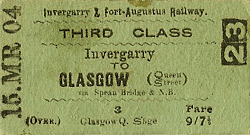 After the First World War, the North British Railway was amalgamated into the London & North Eastern Railway, who used the line largely for freight purposes rather than passenger traffic. The passenger service was withdrawn on 1st December 1933 but the line remained open for freight with a once weekly coal train. During WW2 there was a daily freight service in connection with logging activities. The daily freight train was withdrawn in 1945 and the weekly coal train was withdrawn from 1st January 1947. There was a final special on 28th March 1947 for prospective hiring of the line by a timber merchant but this didn't happen and the track was lifted shortly afterwards. Today some sections of the trackbed are used as a logging road. After the First World War, the North British Railway was amalgamated into the London & North Eastern Railway, who used the line largely for freight purposes rather than passenger traffic. The passenger service was withdrawn on 1st December 1933 but the line remained open for freight with a once weekly coal train. During WW2 there was a daily freight service in connection with logging activities. The daily freight train was withdrawn in 1945 and the weekly coal train was withdrawn from 1st January 1947. There was a final special on 28th March 1947 for prospective hiring of the line by a timber merchant but this didn't happen and the track was lifted shortly afterwards. Today some sections of the trackbed are used as a logging road.
For further information see 'The Invergarry & Fort Augustus Railway' DVD by Jim Broadbent 1966 - Published by Video 125. "The incredible story of the line that should never have been built"
Tickets from Michael Stewart. Route map drawn by Alan Young.
See also the Railscot web site for more photographs of the Invergarry & Fort Augustus Railway.
To see other stations on the Invergarry & Fort Augustus Railway click on the station name: Gairlochy, Invergloy, Aberchalder, Fort Augustus &
Fort Augustus Pier |


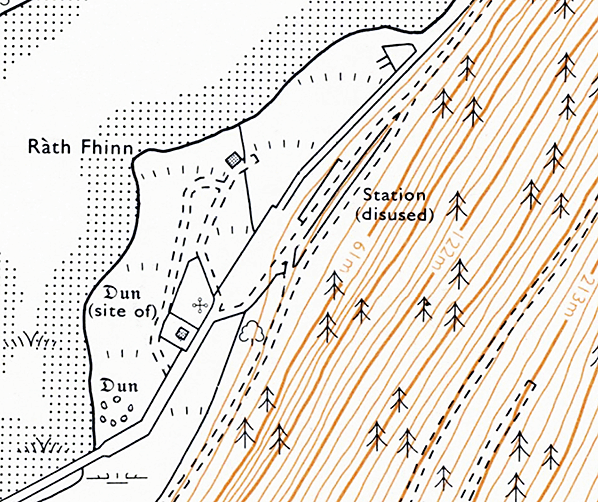
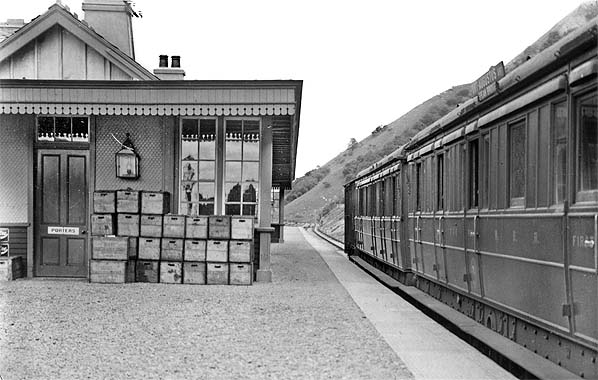
old1.jpg)
old3.jpg)
19.jpg)
14.jpg)
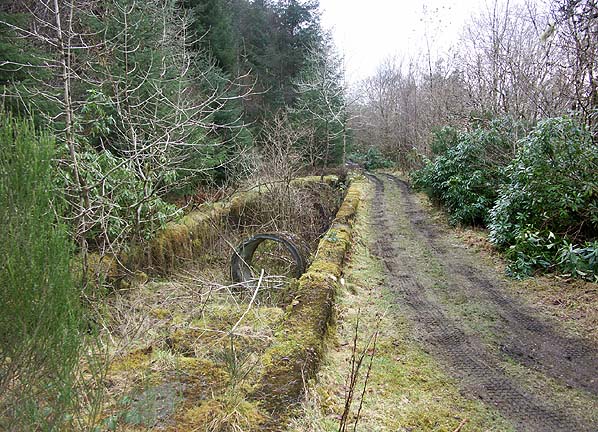
20.jpg)
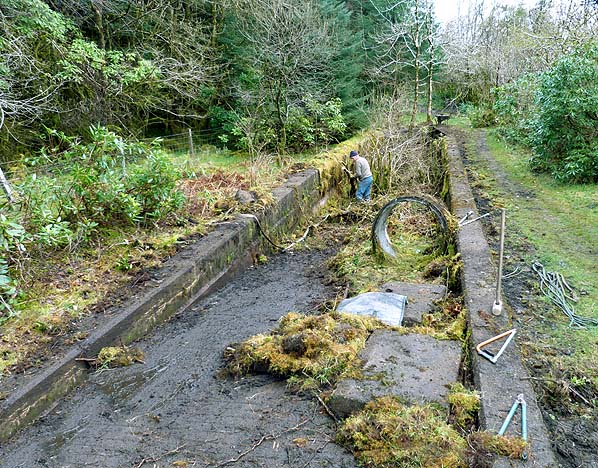
21.jpg)
24.jpg)
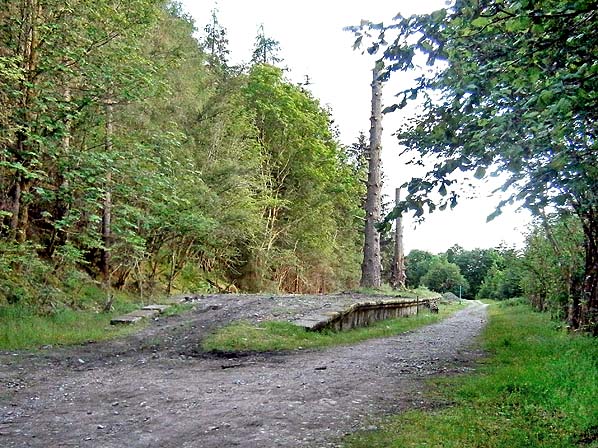
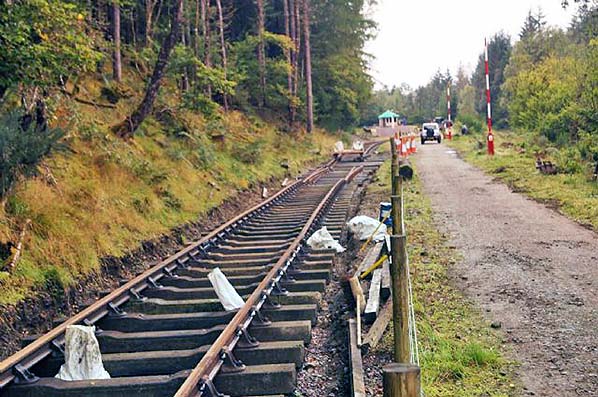
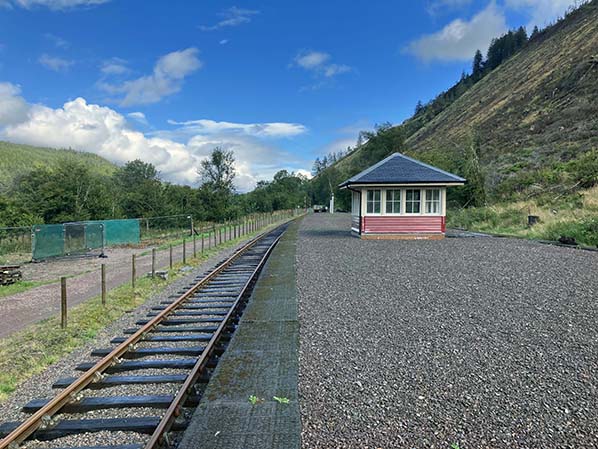
 Home Page
Home Page  In February 2012 a
In February 2012 a  The line was unsuccessfully opposed, by the Highland Railway and the Act was passed on 14th August 1896. Construction started the following year and after a final inspection by the Board of Trade on 14th July 1903, the branch opened eight days later on 22nd July. The line was largely funded by Lord Burton and was an expensive venture, built to main-line standards, so convinced were its promoters that it would ultimately become part of a ‘Great Glen’ trunk route.
The line was unsuccessfully opposed, by the Highland Railway and the Act was passed on 14th August 1896. Construction started the following year and after a final inspection by the Board of Trade on 14th July 1903, the branch opened eight days later on 22nd July. The line was largely funded by Lord Burton and was an expensive venture, built to main-line standards, so convinced were its promoters that it would ultimately become part of a ‘Great Glen’ trunk route. There was a station in the centre of Fort Augustus, but the line extended to a pier on Loch Ness to allow connection with steamers. Other intermediate stations were provided at Aberchalder, Invergarry and Gairlochy. A further station at Invergloy was opened on 1st July 1904. The line was single track throughout with passing places at Gairlochy & Invergarry Stations and at Letterfinlay Crossing which was planned to break the long single track section from Gairlochy to Invergarry. This crossing was never brought into use although signaling equipment was installed and a signal box built.
There was a station in the centre of Fort Augustus, but the line extended to a pier on Loch Ness to allow connection with steamers. Other intermediate stations were provided at Aberchalder, Invergarry and Gairlochy. A further station at Invergloy was opened on 1st July 1904. The line was single track throughout with passing places at Gairlochy & Invergarry Stations and at Letterfinlay Crossing which was planned to break the long single track section from Gairlochy to Invergarry. This crossing was never brought into use although signaling equipment was installed and a signal box built. The line cost £350,000 to build and this cost exhausted the capital of the Invergarry and Fort Augustus Railway Co. with no money left to provide rolling stock and operate the line; so the service was initially provided by the Highland Railway who rented the line at £4,000 per year even though it was detached from its own system. The railway turned out to be a financial disaster. The villages it served were sparsely inhabited and the only forms of revenue were on Market Day and the use of the line by monks attending a Seminary nearby.
The line cost £350,000 to build and this cost exhausted the capital of the Invergarry and Fort Augustus Railway Co. with no money left to provide rolling stock and operate the line; so the service was initially provided by the Highland Railway who rented the line at £4,000 per year even though it was detached from its own system. The railway turned out to be a financial disaster. The villages it served were sparsely inhabited and the only forms of revenue were on Market Day and the use of the line by monks attending a Seminary nearby.
 The section from Fort Augustus Town station to the pier on Loch Ness, incorporating a swing bridge on the canal, a major bridge over the River Lochy a bridge over the main road, a terminal station and pier was closed in 1906 after only three years’ use. The line was worked by the North British Railway from 1st May 1907 but between 1st November 1911 and 1st August 1913 there was no service at all, as the North British was not prepared to lose any more money and were only willing to restore a service when the line was sold outright to them. They paid £27,000 for the line and the Fort Augustus Hotel, a fraction of the £350,000 cost of building the branch. They were then able to operate the line under the North British Railway (Invergarry and Fort Augustus) Vesting and Confirmation Act of 28th August 1914.
The section from Fort Augustus Town station to the pier on Loch Ness, incorporating a swing bridge on the canal, a major bridge over the River Lochy a bridge over the main road, a terminal station and pier was closed in 1906 after only three years’ use. The line was worked by the North British Railway from 1st May 1907 but between 1st November 1911 and 1st August 1913 there was no service at all, as the North British was not prepared to lose any more money and were only willing to restore a service when the line was sold outright to them. They paid £27,000 for the line and the Fort Augustus Hotel, a fraction of the £350,000 cost of building the branch. They were then able to operate the line under the North British Railway (Invergarry and Fort Augustus) Vesting and Confirmation Act of 28th August 1914.
 After the First World War, the North British Railway was amalgamated into the London & North Eastern Railway, who used the line largely for freight purposes rather than passenger traffic. The passenger service was withdrawn on 1st December 1933 but the line remained open for freight with a once weekly coal train. During WW2 there was a daily freight service in connection with logging activities. The daily freight train was withdrawn in 1945 and the weekly coal train was withdrawn from 1st January 1947. There was a final special on 28th March 1947 for prospective hiring of the line by a timber merchant but this didn't happen and the track was lifted shortly afterwards. Today some sections of the trackbed are used as a logging road.
After the First World War, the North British Railway was amalgamated into the London & North Eastern Railway, who used the line largely for freight purposes rather than passenger traffic. The passenger service was withdrawn on 1st December 1933 but the line remained open for freight with a once weekly coal train. During WW2 there was a daily freight service in connection with logging activities. The daily freight train was withdrawn in 1945 and the weekly coal train was withdrawn from 1st January 1947. There was a final special on 28th March 1947 for prospective hiring of the line by a timber merchant but this didn't happen and the track was lifted shortly afterwards. Today some sections of the trackbed are used as a logging road.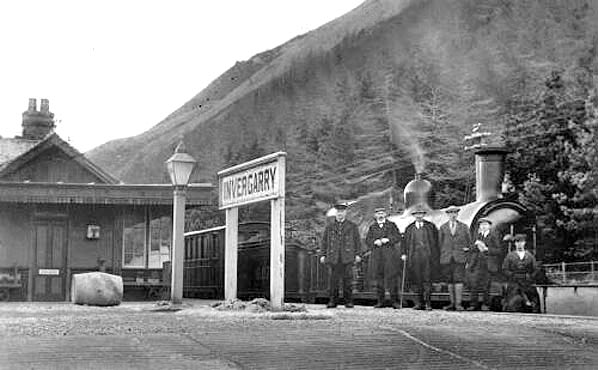
12.jpg)
